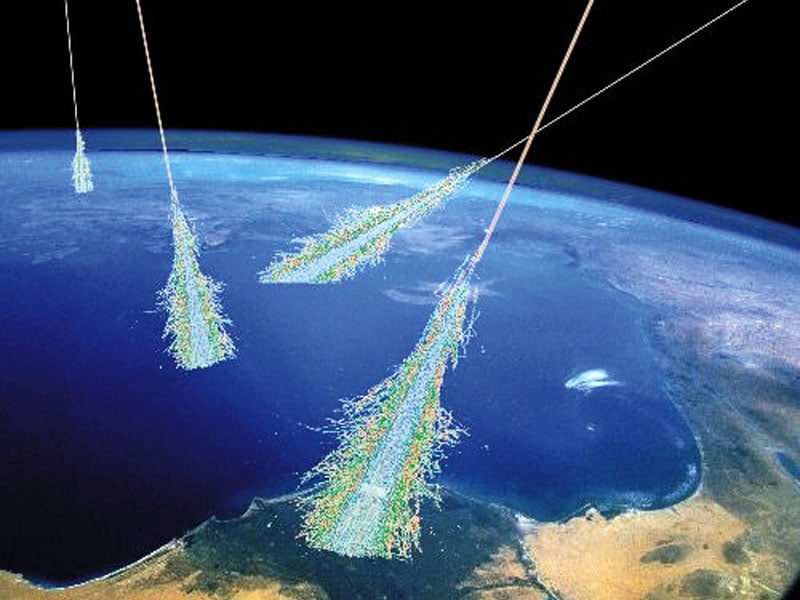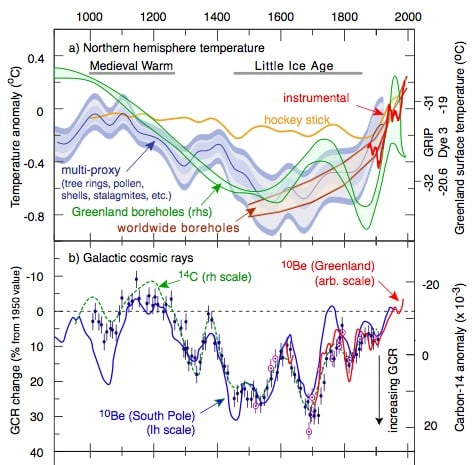Planet’s Temperature Controls CO2 Emissions, not Humans
August 5, 2011 1 Comment
Human emissions do not control the climate or the planet’s CO2 levels.
by Luis R. Miranda
The Real Agenda
August 5, 2011
In recent days, it was revealed that NASA’s satellite data for the years of 2000 through 2011 showed Earth’s atmosphere had allowed more heat to be released into space than previously presented by climate change alarmists. The latest study was published in the peer-reviewed Remote Sensing Science Journal. Although United Nations sponsored studies and those of other climate change alarmist organizations warned us about how global warming would dramatically increased in the coming years, the study published on Remote Sensing proves otherwise, which should at least make some room for the alarmists to review their numbers.
Given the fact more heat was released into space than previously thought, the planet’s atmospheric CO2 concentrations seem to be a less important factor when it comes to planetary temperature increases. Atmospheric CO2 traps less heat than alarmists said it does. One of the co-authors of the study, Dr. Roy Spencer, from the University of Alabama in Huntsville and says that what is called real world data from NASA’s Terra satellite contradict previous assumptions fed into alarmist computer models. “The satellite observations suggest there is much more energy lost to space during and after warming than the climate models show. There is a huge discrepancy between the data and the forecasts that is especially big over the oceans.”
Along with the study cited above, comes a new study from Professor Murry Salby who is the Chair of Climate Science at Macquarie University. Professor Salby observed C12 and C13 ratios and CO2 levels around the world for the past two years. The results of his observations conclude that man-made emissions have only a small effect on global CO2 levels. Man-made emissions do not control climate and neither do they control CO2 levels. Professor Salby related his findings in a speech called: “Global Emission of Carbon Dioxide: The Contribution from Natural Sources” Listen to Professor Salby’s conference here.
As it has been proven previously, the oceans and large green areas of the planet emit more CO2 into the atmosphere than all human activity. Industrialization emits about 5 gigatons of CO2 per year, while the oceans emit 90 gigatons and plant life on land emit some 6o gigatons.
“It is often asserted that we can measure the human contribution of CO2 to the air by looking at the ratio of C12 to C13. The theory is that plants absorb more C12 than C13 (by about 2%, not a big signature), so we can look at the air and know which came from plants and which came from volcanos and which came from fossil fuels, via us. Plants are ‘deficient’ in C13, and so, then, ought to be our fossil fuel derived CO2. The implication is that since coal and oil were from plants, that “plant signature” means “human via fossil fuels”. But it just isn’t that simple. We are 5.5 and plants are putting 121.6 into the air each year (not counting ocean plants). There is a lot of carbon slopping back and forth between sinks and sources. Exactly how closely do we know the rate of soil evolution of CO2, for example?”
 While satellite measurements tell us the planet let out more heat than it was believed by climate change alarmists, they also help us localize “hotspots” for CO2 emissions. The ‘novelty’ with satellite observations is that large cities in heavily industrialized countries are not part of those “hotspots”. The main sources of CO2 emissions are places with large areas covered by vegetation like the Amazon, tropical areas, southeast Asia, and tropical Africa.
While satellite measurements tell us the planet let out more heat than it was believed by climate change alarmists, they also help us localize “hotspots” for CO2 emissions. The ‘novelty’ with satellite observations is that large cities in heavily industrialized countries are not part of those “hotspots”. The main sources of CO2 emissions are places with large areas covered by vegetation like the Amazon, tropical areas, southeast Asia, and tropical Africa.
As data shows, more CO2 concentrations are found when the planet experiences warming due to phenomena such as the El Niño Southern Oscillation (ENSO). Conversely, less concentration of CO2 is recorded when the planet experiences more volcanic activity because the large clouds of ash that the volcanoes emit help to keep the planet cooler. So, during warmer years, the levels of CO2 were smaller, while in colder years the concentrations were larger. Temperature controls CO2 levels in the atmosphere, not human emissions.
The failure of the climate models usually taken as proof to argue that the planet is experiencing global warming or that human activity is responsible for climate change is the fact those climate models are prepared to assume that human CO2 emissions, that result from industrialization are responsible for the warming and the changes in climate. As it has been abundantly proven, climate changes occur through centuries or millenia, not decades or years.
Professor Salby believes that temperature variations explain the different CO2 concentrations.
The NASA Terra satellite data support other NOAA and NASA data that indicated that atmospheric humidity and cloud formation do not increase in the way climate alarmists say they do. “Both the NASA ERBS and Terra satellite data show that for 25 years and counting, carbon dioxide emissions have directly and indirectly trapped far less heat than alarmist computer models have predicted.”

As a third caveat to the global warming and climate change debate, an article dated July 19, 2011 from The Register, reveals how the chief of the world’s leading physics lab at CERN in Geneva prohibited scientists to talk about the results of recent experiments that prove how solar energy particles determine cloud formation in our planet. The CLOUD (“Cosmics Leaving Outdoor Droplets”) experiment uses CERN’s proton synchrotron to examine nucleation.
CERN Director General Rolf-Dieter Heuer managed to tone down the fact that solar activity is the main driver of climate in the solar system, saying that “cosmic radiation is only one of many parameters.”Heuer added that if the results were published, they would be turned into tools for political debate.
The CLOUD experiment are based on previous experiments by physicist Henrik Svensmark. “He demonstrated that cosmic rays provide a seed for clouds. Tiny changes in the earth’s cloud cover could account for variations in temperature of several degrees. The amount of Ultra Fine Condensation Nuclei (UFCN) material depends on the quantity of the background drizzle of rays, which varies depending on the strength of the sun’s magnetic field and the strength of the Earth’s magnetic field.”
Veteran science editor Nigel Calder says that CERN’s policy to remain politically correct when it comes to the global warming or climate change debate is not surprising. He adds that it is a common occurrence for organizations like CERN not to want to discuss the results of experiments or observations that do not support their theories. “It’s OK to enter ‘the highly political arena of the climate change debate’ provided your results endorse man-made warming, but not if they support Svensmark’s heresy that the Sun alters the climate by influencing the cosmic ray influx and cloud formation.”
These three examples of how more recent solid science proves that the alarmist-driven global warming movement has been lied to does not even consider the infamous Climategate emails that showed the corruption of a section of the scientific community. Is there any need for further evidence to disprove the fake global warming alarmism? There is certainly a stronger need to keep on studying climate and how it changes without proposing insane global weather modification practices such as employing nuclear weapons to reverse climate change, the spraying of toxic chemicals to block the sun from driving life on the planet, propose population reduction as a way to curb CO2 emissions, de-industrialize the planet to keep it for the animals as they are equaled to humans, adopt genetically modified organisms to feed the world because it has a smaller CO2 footprint and a host of other demented practices now being proposed by failed politicians, governments and international organizations.



